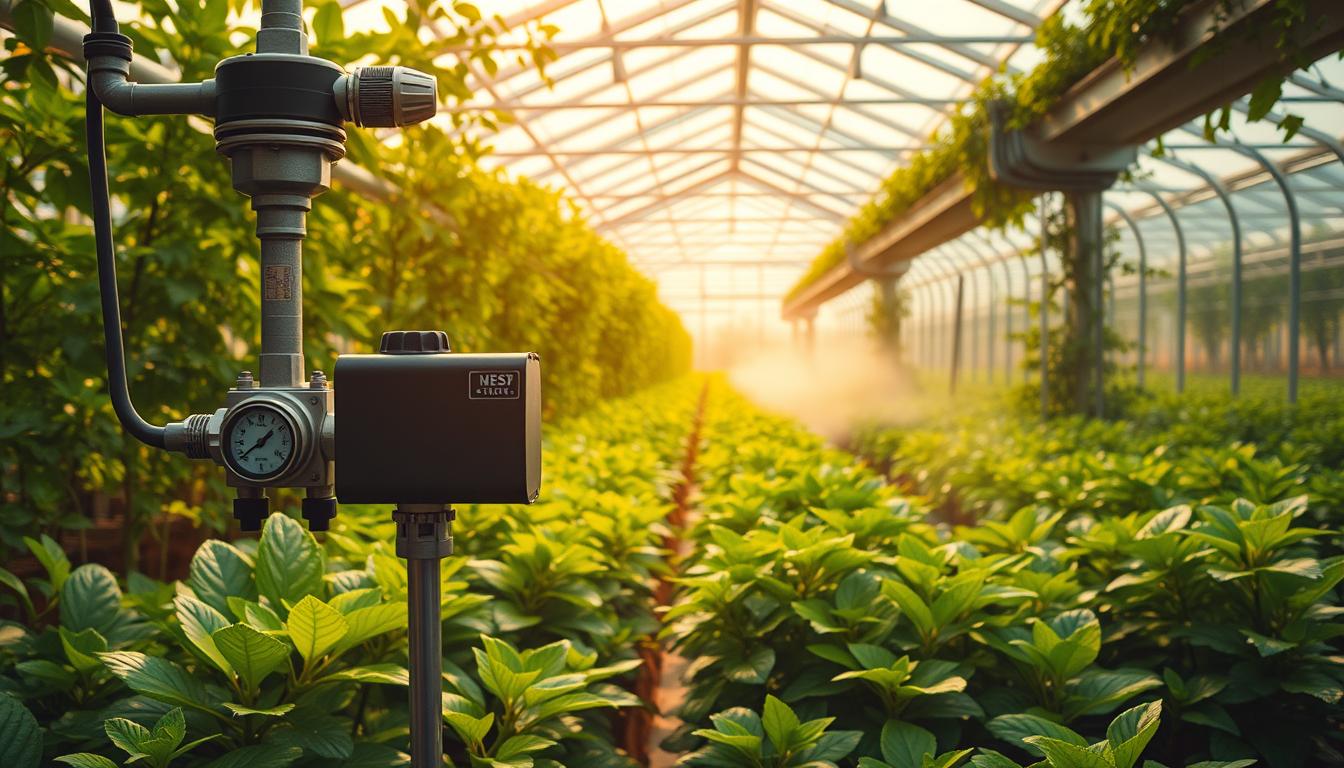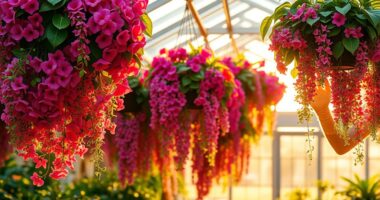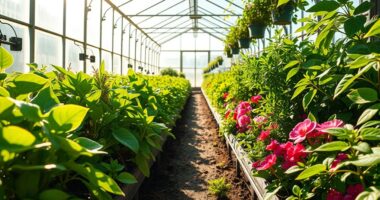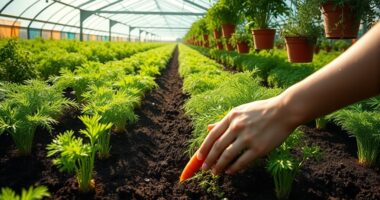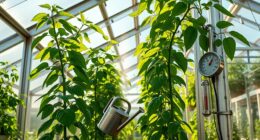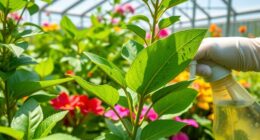Did you know keeping the right humidity in your greenhouse cuts down the risk of plant fungi by up to 80%? If you grow plants in a greenhouse, it’s key to keep the moisture levels just right. This not only helps your plants grow better but also stops diseases that come from too much dampness1. The most trouble with humidity happens in the fall and spring. So, it’s important to know how it changes over the year. By keeping the moisture levels under control, you make a great space for your plants. This helps them grow more and faces fewer problems.
This article talks about how important it is to manage humidity in greenhouses. And, it offers tips designed to fit your plants’ needs. You’ll find out how moisture affects photosynthesis and how plants get nutrients. Plus, learn the top ways to keep humidity perfect so your plants do well.
Key Takeaways
- Optimal humidity control is essential for preventing fungal diseases and ensuring healthy plant growth.
- Humidity levels in greenhouses should ideally be between 65% to 75% at night and 80% to 90% during the day2.
- Maintaining the right conditions can help reduce excessive condensation and its associated risks3.
- Effective air circulation is key to balancing humidity levels and preventing moisture build-up.
- Utilizing technology, such as humidity sensors, can enhance your ability to monitor and control greenhouse conditions.
Introduction to Humidity Control in Greenhouses
Controlling humidity is key for growing healthy plants in greenhouses. It’s very important, especially when the seasons change. At these times, plants can easily get sick. Keeping the right level of humidity stops water build-up, which can lead to plant diseases. Did you know that plants give off 90% of the water they take in? This leaves only 10% for them to grow. So, humidity has a big effect on how well they do4.
Keeping humidity at the best level means plants are less likely to get pests and diseases. This could also save money on sprays and make a better environment for your plants. Using things like dehumidifiers or misters can help deal with challenges from the weather. These tools help make the perfect home for different plants5. By keeping humidity just right, your greenhouse will do better and plants will grow well.
The Importance of Humidity in Plant Growth
Knowing how humidity affects plant life is key for any greenhouse. Humidity impacts important plant functions like making food through photosynthesis and absorbing nutrients. Keeping the right level of humidity boosts plant health and increases what they produce.
How Humidity Affects Photosynthesis
Humidity is vital for making food in plants because it affects how much water plants lose through their leaves. If the air is too dry, plants might lose too much water and struggle to make food. This process is crucial for plant growth. Keeping the air moist but not too wet, around 80% at 80°F (27°C), helps plants stay healthy6. Yet, too much moisture can lead to diseases like powdery mildew, hurting the plants7.
The Role of Humidity in Nutrient Uptake
Humidity’s effect on how plants take in food and water is huge. When the air is moist enough, plants can better absorb the water and nutrients they need. If it’s too dry, their growth can be slowed down6. Big changes in air moisture can also make plants weaker and lower the quality of what they produce8. For most plants in greenhouses, keeping the air humidity between 65% and 90% is perfect for their growth and health.
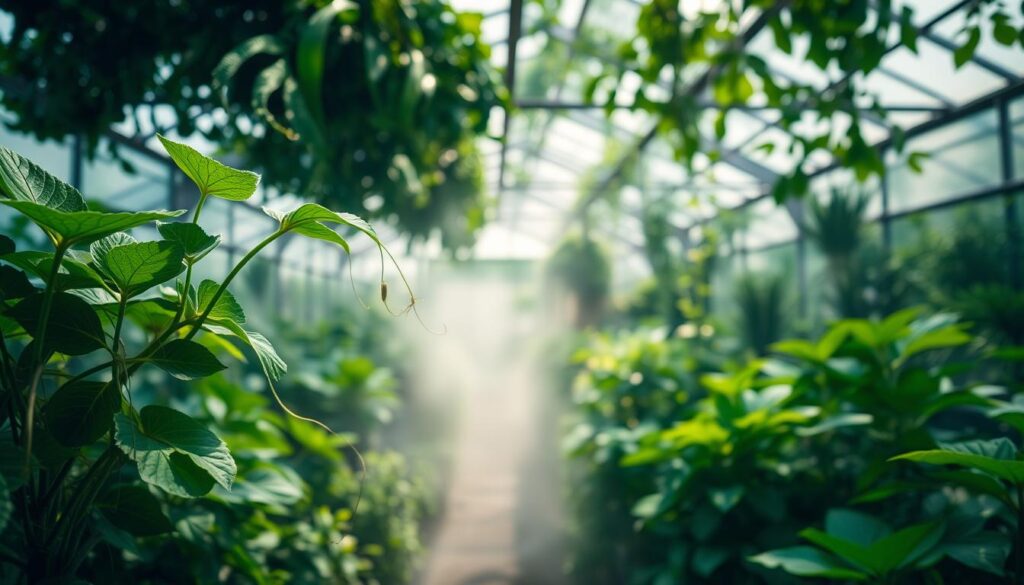
Understanding Relative Humidity in Greenhouses
Relative humidity (RH) shows how much moisture the air holds compared to the most it can at a certain temperature. This is key in a greenhouse environment for growing healthy plants and keeping conditions just right. Warm air can keep more moisture than cool air. This means the humidity in your greenhouse changes with the temperature. For example, air at 60ºF can hold over five times as much water vapor as air at 20ºF9.
Keeping the RH level correct is very important. Tomato plants do well when humidity is between 45% and 100%, without any harm. But, quick changes in humidity can harm plant tissue. A fast change of 20% in RH can cause damage9. When RH goes above 85%, it gets tough to control moisture. This can lead to too much condensation and less nutrient uptake because plants can’t breathe well10.
Knowing about RH helps you water your plants just right. The best humidity levels make for strong photosynthesis and healthy plants. But, if the humidity isn’t right, problems like blossom end rot in tomatoes can happen 10 to 14 days after the damage starts9. That’s why it’s important to keep checking and adjusting RH for the best greenhouse environment.

Relationship Between Temperature and Humidity
The way temperature and humidity work together is key in managing a greenhouse. Knowing how they affect water in the air helps make a better place for plants to grow.
How Warm Air Affects Moisture Retention
As the air gets warmer, it can hold more water, which makes the air less humid. This temperature influence matters a lot for plants. Greenhouses work best at temperatures between 64 to 75 ºF for plant growth11. Lower humidity makes it hard for plants to get water and nutrients, leading to weak growth or wilting. For good health, many plants need humidity around 80%12.
The Dew Point and Its Significance
The dew point importance in controlling humidity is something we can’t ignore. It’s the point where air gets so full of water it starts to condense. If leaves get colder than this point, they get wet, which can cause fungi like botrytis or powdery mildew11. To stop these problems, keep humidity at 65 to 75% at night and about 80% during the day11.
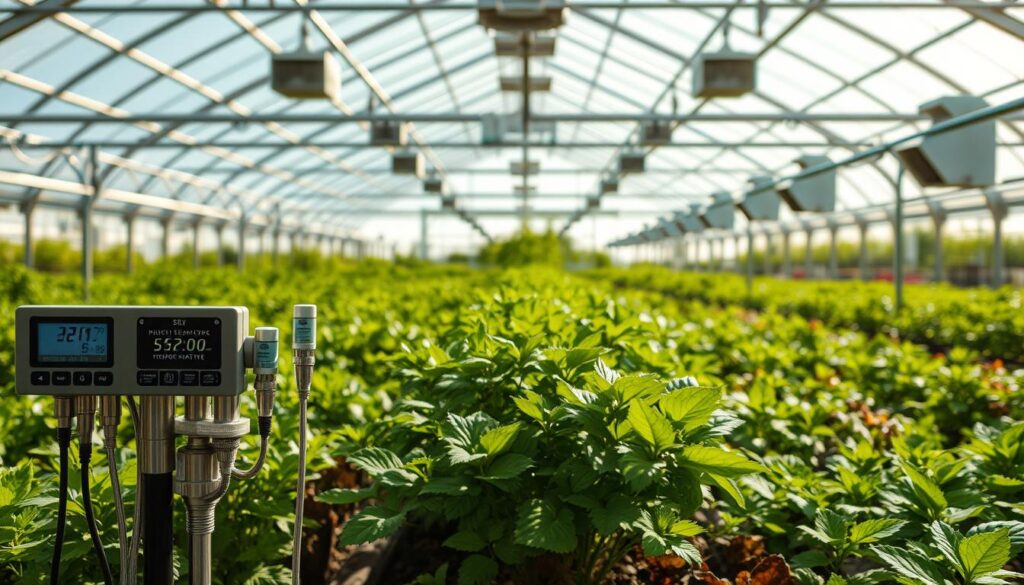
Common Humidity-Related Challenges
Managing humidity in greenhouses is key to stop major disease problems. Growers often deal with issues from fungal pathogens. These can harm crops seriously if not controlled. Knowing about the humidity challenges, especially those from too much moisture, is crucial.
Fungal Pathogens and Disease Prevention
Fungal pathogens like botrytis and powdery mildew are big worries. Botrytis affects almost all greenhouse crops, showing as gray mold 2-3 weeks after infection13. These outbreaks usually happen in spring. The fungi grow best at 24°C (75°F)13.
To fight these diseases, keep humidity under 80% by day and 65% at night14. Good gardening practices and cleanliness help lower these risks a lot.
The Risks of High Humidity Levels
High humidity can cause many problems. For example, it can help powdery mildew spores grow, especially in spring and fall13. Humidity over 90% can make condensation that’s perfect for fungus and bacteria14. This situation can also lead to tomato splitting and edema13.
Keeping humidity between 40% and 80% is vital for disease prevention14.
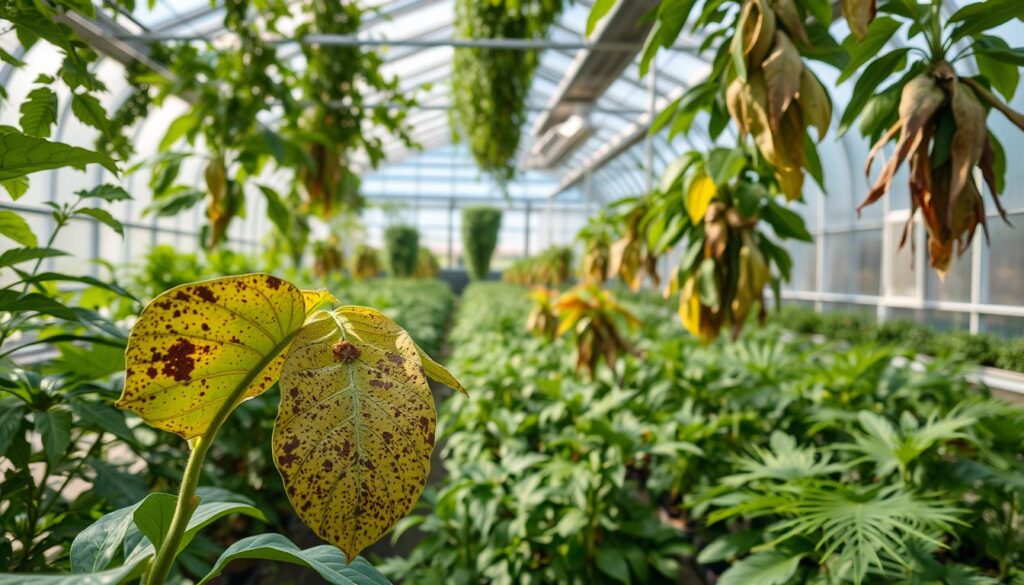
Humidity Control Greenhouse: Strategies and Techniques
Keeping the right humidity is key for plant growth and health in greenhouses. You can use several ways to do this, like making sure there is good airflow and using machines that remove dampness to keep humidity just right. These methods help plants grow well and stay healthy.
Ventilation Techniques for Humidity Control
Ventilation is very important for controlling humidity. By letting in dry air and getting rid of moist air, plants stay healthier. But, you have to think about the weather outside too; if it’s very humid, your ventilation might not work as well.
Using manual or automatic systems to move air can help avoid too much moisture. Opening the greenhouse early in the day can also help manage both warmth and humidity, making plants happier.
Use of Dehumidifiers and Misting Systems
Dehumidifiers really help, especially where it’s usually very humid or during the rainy times. They keep moisture levels perfect for plants to breathe properly. Also, using misting systems with dehumidifiers can make the perfect environment but avoid too much wetness.
Having these systems work automatically is best. They can adjust based on current humidity for the best plant growth. Using these tools means your plants will do better. You’ll also use your resources in a smarter way in your greenhouse151617.

Recommended Humidity Levels for Various Crops
Each crop needs different humidity levels, which is very important for their growth18.Most times, crops do well when the humidity during the day is around 80%. At night, it should be lower, between 65-75%19. Knowing the right moisture levels makes a big difference in your plants’ health and yield.
For plants like tomatoes, they need 80-90% humidity during the day20.At night, keeping humidity at 65-75% is best. This balance helps prevent diseases like botrytis and powdery mildew, especially at high humidity19. Using humidity sensors can help keep these levels just right for healthy plants.
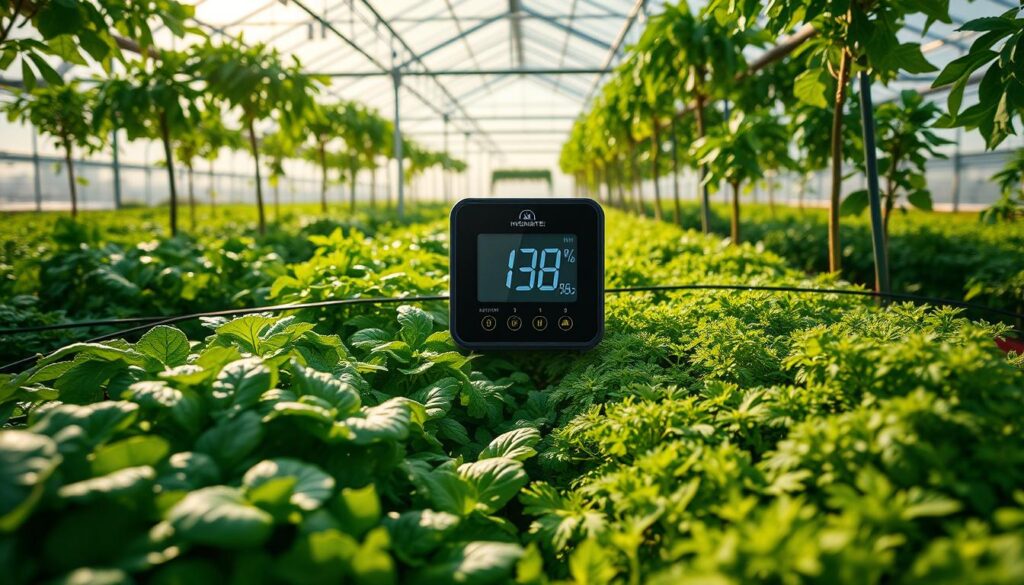
Cultural Practices to Manage Humidity
Managing humidity in greenhouses is crucial, and the right practices make a big difference. Watering methods and timing are key. Water plants early in the day. This helps them absorb moisture before it gets cold at night, reducing unwanted humidity. Another important part is your plant layout. Spacing plants right lets air move freely, keeping moisture levels down under thick plant areas.
Watering Techniques and Timing
Using the right watering techniques can cut down on humidity. Tools like drip irrigation or moisture gauges help give plants the right amount of water without making the soil too wet. Doing this keeps plants healthy and lowers the risk of diseases from too much moisture. Checking regularly when to water, based on your greenhouse’s climate, is key.
Plant Spacing and Arrangement
The way you set up your plant layout affects humidity control. Properly spaced plants promote better air flow and reduce moisture buildup. The goal is to find the right space between plants that encourages both air movement and healthy growth. This approach is crucial for a good growing environment and helps prevent humidity-related diseases, such as powdery mildew.

Importance of Air Movement in Greenhouses
Air movement is key in keeping a greenhouse perfect for plants. Good airflow stops too much humidity, which cuts down on fungal diseases. Warm, damp air that doesn’t move is a haven for germs. So, moving air around stops disease and makes plants healthier. It’s vital to have a plan to keep air moving well where your plants are growing.
How Airflow Reduces Fungal Diseases
Keeping air moving stops plant diseases like powdery mildew and botrytis. Greenhouses need to be built to lower humidity around plants. They do this with vents in roofs and walls, covering 15-20% of the floor space for the best airflow21. Studies show that a breeze of 2-3 miles per hour can ventilate over 80% effectively21. Fans that exchange all the air every minute can warm the air by 8-10°F from the intake to the fan, improving humidity21.
Better air circulation boosts crop yields by 6.4%22. It also cuts heating energy use by 12%, thanks to more even air mixing22. Although the savings in energy costs vary, upgrading your airflow system can be a smart move22.
| Air Movement Systems | Key Benefits | Cost Consideration |
|---|---|---|
| Fan Systems | Increased crop yields by 6.4% | Installation costs of £1.75 per square meter |
| Ventilation Systems | Effective disease prevention | Running costs around £27 per week per hectare |
| Duct Systems | Reduced temperature variation to 0.5°C | Investment of about £12,000 per hectare |

Technology for Monitoring Humidity
Using modern tools in your greenhouse is key for checking humidity levels well. With humidity sensors and systems that monitor conditions automatically, you can make smart choices quickly. This technology helps you keep your crops growing in just the right environment.
Humidity Sensors and Monitoring Systems
Sensor technology today is really precise and reliable for measuring in greenhouses. With technology like wireless sensors, you get real-time info on how your plants are doing. This means you can use tools such as the Priva Cloud23 without delay. By using smart systems that keep an eye on things like humidity and temperature, your plants can thrive. These tools do more than monitor; they also control watering, saving a lot of water.
Integrating Technology for Better Control
Innovative technology gives you better management of your greenhouse environment. For instance, automatic pest control lowers the need for pesticides. This makes for a healthier place for your plants to grow24. Success stories from customers show that using advanced systems can lead to better crop health. Products like the Temp Stick – WiFi Temperature and Humidity Sensor, which costs $139, give you fast updates. This helps you manage humidity better and more timely25.

Cost Implications of Humidity Management
Managing humidity in greenhouses affects both daily costs and future investments. It’s important to know how much humidity control costs to make your operations more efficient and increase crop yield. Higher energy prices have made people think more about humidity management. This was very clear in 2008 when energy markets were unstable. A nursery saw that less humidity control caused more diseases because humidity went up to 90% without it. With control, it stayed around 85%26. This shows spending on humidity control now can bring big benefits later.
Operational Cost Considerations
Energy use is a big part of the cost of running a greenhouse. It’s mostly from heating and cooling. A greenhouse with active humidity control used more energy because it ran for 14 hours at a higher temperature. A similar greenhouse without this system ran cooler and less, which was cheaper26. The cost of humidity control was 1.75 p/m², making it about 0.2 p per plant with 9 plants per square meter26. It’s important to think about these costs when planning your greenhouse budget.
Investment in Long-term Solutions
Setting up a climate-controlled greenhouse costs between $200,000 and $300,000. This shows how big an investment greenhouses are, largely due to energy costs27. Keeping the greenhouse running means hiring 1 or 2 people. But, smart control systems can save money and improve efficiency over time27. Where your greenhouse is also matters; cold places need good heating, and hot places need cooling27. These choices affect both the money you need at the start and the profits you’ll make from better crops.
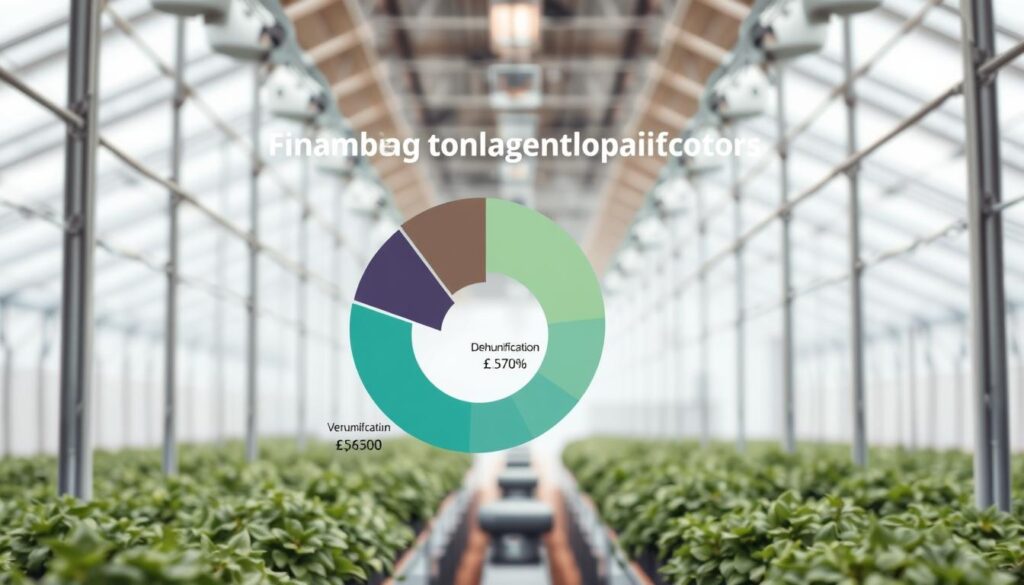
Best Practices for Maintaining Desired Humidity Levels
Keeping the right humidity in your greenhouse is key for plant health and growth. Using the best techniques is crucial. By performing regular checks and adjusting for seasons, you can make sure your plants are happy all year.
Regular Maintenance Tips
It’s important to keep an eye on your greenhouse’s humidity system. Check and adjust humidity sensors for better accuracy and monitoring. This ensures your plants live in the best condition.
Proper ventilation keeps moisture from getting too high. Using digital tools helps track humidity easily. A dry greenhouse floor keeps away water and diseases28. Make sure your dehumidifiers work well to control moisture without wasting energy.
Seasonal Adjustments to Humidity Control Methods
Adjusting humidity with the season is a must. In the warm months, aim for 60% to 70% to avoid plant diseases29. When it’s cooler, higher humidity around 80% supports growth, especially at 80°F (27°C)29. Evening misting practices can also boost humidity when needed.
Remember, consistent humidity levels are vital for plants to take up nutrients and stay healthy.

Conclusion
Understanding humidity control is key in greenhouse growth. Keeping humidity right helps plants grow well and fight off diseases. For plants like tomatoes, aim for humidity between 65-75% at night for the best harvest30.
Knowing how humidity and temperature affect plant health lets you solve problems better. Use tools like wireless sensors for real-time humidity or try passive ventilation. These methods improve crop growth and are good for the environment too31.
Good greenhouse management is about making constant improvements. By applying what you’ve learned, you can create a better growing space. This leads to healthier plants and more success in farming.
FAQ
Why is humidity control important in greenhouses?
What are the recommended humidity levels for greenhouse crops?
How does humidity affect photosynthesis?
What challenges arise from high humidity in greenhouses?
What strategies can I use to control humidity in my greenhouse?
How does air movement help manage humidity levels?
What role does technology play in humidity management?
Are there cost considerations involved in humidity management?
How can I maintain my humidity control systems effectively?
Source Links
- Reducing Humidity in the Greenhouse – https://ag.umass.edu/greenhouse-floriculture/fact-sheets/reducing-humidity-in-greenhouse
- Greenhouse Ventilation and Cooling: Humidity Control – https://www.greenhouse-management.com/greenhouse_management/greenhouse_ventilation_cooling/greenhouse_humidity_control.htm
- How To Control Humidity In A Greenhouse – https://greenhouseemporium.com/control-humidity-in-greenhouse/?srsltid=AfmBOoruOEoPO6mVFaIKBergVMk5zF8YwfjtCGKADNrO1K-TBOPpsWA-
- Humidity and Greenhouse Climate Control: A Brief Introduction | GrowSpan – https://www.growspan.com/news/humidity-greenhouse-climate-control-brief-introduction/
- How Do I Control Humidity in My Greenhouse? – https://ceresgs.com/how-do-i-control-humidity-in-my-greenhouse/
- How To Control Humidity In A Greenhouse – https://greenhouseemporium.com/control-humidity-in-greenhouse/?srsltid=AfmBOoo_AwVDxNT0971wDvXm1lbjBp7YyVi07r6FgE9oFs-v24wjO_Re
- Reduce Greenhouse Humidity | Integrated Pest Management – https://ipm.cahnr.uconn.edu/reduce-greenhouse-humidity/
- Ideal Greenhouse Temperature And Humidity | Atlas Scientific – https://atlas-scientific.com/blog/ideal-greenhouse-temperature-and-humidity/?srsltid=AfmBOoofYRJROE4NCCStMF5OY4kwa2TQfZUbjGhQaZFu_QGicjVzCTpn
- Relative Relative Humidity – https://cropking.com/blog/relative-relative-humidity
- New Grower Information Package – https://www2.gov.bc.ca/assets/gov/farming-natural-resources-and-industry/agriculture-and-seafood/animal-and-crops/crop-production/understanding_humidity_control.pdf
- Ideal Greenhouse Temperature And Humidity | Atlas Scientific – https://atlas-scientific.com/blog/ideal-greenhouse-temperature-and-humidity/?srsltid=AfmBOorF7HFLUwf4DBrHb8P-IfKzGj2u2MTHXhyUiqZ1tskm5b8MxlT6
- Humidity and temperature control in greenhouses – https://www.processsensing.com/en-us/blog/humidity-temperature-control-green-houses.htm?srsltid=AfmBOoruKJzmwUnonh17ZvODS0pxkDrQMxCX9dV6srJxN3YQeNir2cpL
- Humidity Related Problems: Common Greenhouse Humidity Diseases – DryGair – https://drygair.com/blog/humidity-woes-common-greenhouse-humidity-related-problems/
- How can you maintain the ideal humidity in a greenhouse? – https://ruuvi.com/how-can-you-maintain-the-ideal-humidity-in-a-greenhouse/?srsltid=AfmBOooVBKsPlEaFRPIdssxi3ovrJCYWyMVXO77NAWxwkxRrZeCSg-Fr
- How To Control Humidity In A Greenhouse – https://greenhouseemporium.com/control-humidity-in-greenhouse/?srsltid=AfmBOoq5A3VYrdJjP_pPefEsjJq9iDmknjiEEBkLhF5ZpS3cKiDqezoZ
- Greenhouse humidity control | Avoid excessive humidity – https://royalbrinkman.com/knowledge-center/technical-projects/greenhouse-humidity-control
- How To Control Humidity In The Greenhouse? – https://themarketgardener.com/farming-techniques/how-to-control-humidity-in-the-greenhouse/
- Optimal Humidity and Temperature for Greenhouse Growing – DryGair – https://drygair.com/blog/optimal-humidity-temperature-greenhouse/
- Ideal Greenhouse Temperature And Humidity | Atlas Scientific – https://atlas-scientific.com/blog/ideal-greenhouse-temperature-and-humidity/?srsltid=AfmBOoobn2X9343iBHpAz1jOv470AJtUjdP_3UA5Cb4FX73FhRe3Ch_p
- How can you maintain the ideal humidity in a greenhouse? – https://ruuvi.com/how-can-you-maintain-the-ideal-humidity-in-a-greenhouse/?srsltid=AfmBOooyFm1AtsNooaRFZKFqtTYHJ576EJREA4899S0lKD0m3fZ81MzM
- Ventilation for Greenhouses – https://ag.umass.edu/greenhouse-floriculture/fact-sheets/ventilation-for-greenhouses
- Introduction to air movement in greenhouses – Growsave – https://www.growsave.co.uk/introduction-to-air-movement-in-greenhouses/
- Greenhouse monitoring systems and sensor technology | Priva – https://www.priva.com/horticulture/greenhouse-monitoring-measurement
- What is a Greenhouse Monitoring System & How Does It Work? – Sirin Software – https://sirinsoftware.com/blog/what-is-a-greenhouse-monitoring-system-how-does-it-work
- Greenhouse Temperature Monitor – Temp Stick – https://tempstick.com/greenhouses/?srsltid=AfmBOorRdCJVwNOIEm7SyW1zrgbLWY6WYN2odV4fz2NhvvSvrtiCcrrF
- What is the cost of humidity control in your glasshouse? – https://horticulture.ahdb.org.uk/knowledge-library/what-is-the-cost-of-humidity-control-in-your-glasshouse
- Climate Controlled Greenhouse Cost: A Comprehensive Investment Guide – INSONGREEN – https://www.insongreen.com/climate-controlled-greenhouse-cost-analysis/
- How Can We Maintain the Humidity Inside a Greenhouse? – https://www.greenhousestores.co.uk/blog/How-Can-We-Maintain-The-Humidity-Inside-A-Greenhouse/?srsltid=AfmBOortqHv4EswfGSMrr_C2XZ6B19GX_EjGpP-4v7cOoPre8xd755-F
- How To Control Humidity In A Greenhouse – https://greenhouseemporium.com/control-humidity-in-greenhouse/?srsltid=AfmBOoqQu2UqkDVX9XmktznL0iHvFAaEyt9MDLUk-F-cr-jnC-aDkgt9
- How can you maintain the ideal humidity in a greenhouse? – https://ruuvi.com/how-can-you-maintain-the-ideal-humidity-in-a-greenhouse/?srsltid=AfmBOorT5W4oU14vrx3g_O2fM6eQyP0n-1uY–7qw2GERqZ59DHHx_3R
- Managing a Greenhouse | Regulating Humidity & Temperatures – Bootstrap Farmer – https://www.bootstrapfarmer.com/blogs/building-a-greenhouse/managing-a-greenhouse-regulating-humidity-temperatures?srsltid=AfmBOorkAfcS_vO0gwk2Dqjm0qyaztcKJ7Js6JsrUUFhVCvdk1uN6GSt
